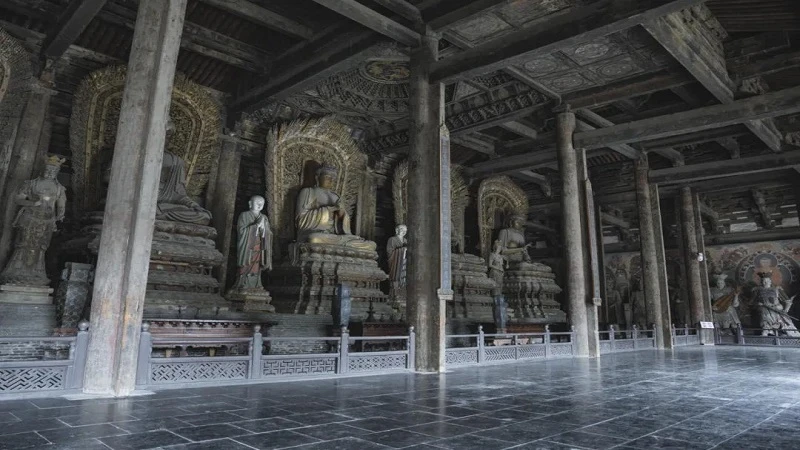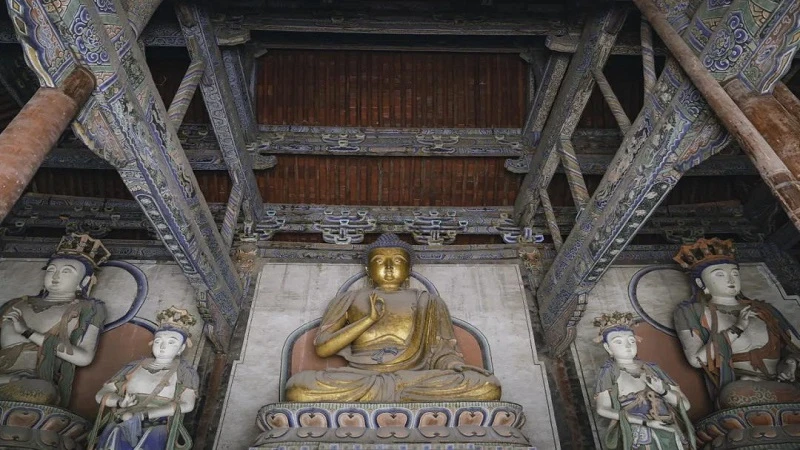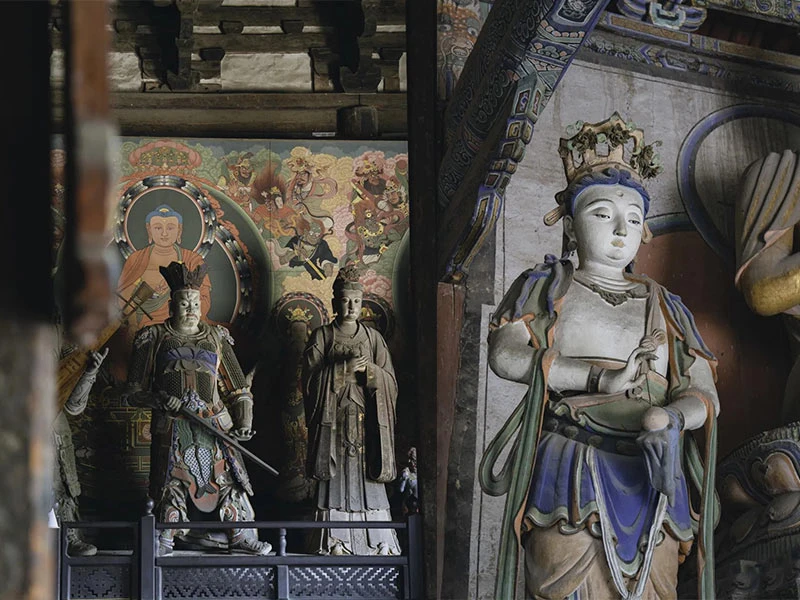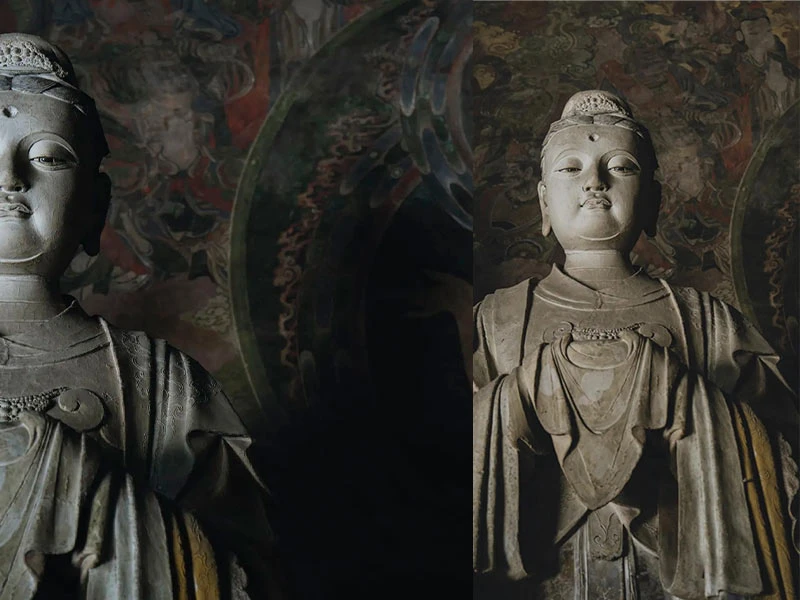Nestled in the heart of Datong, Shanxi, Shanhua Temple (善华寺) stands as a testament to the architectural brilliance of the Jin and Liao dynasties. Officially known as the Ancient Shanhua Temple, it houses some of China's most significant historical treasures. While Datong's fame is often associated with the Yungang Grottoes and the Huayan Temple, Shanhua Temple quietly holds its own, attracting those who seek the profound beauty of ancient art.
Famed architects Liang Sicheng and Lin Huiyin once praised the temple in their Report on Ancient Architecture in Datong, marveling at its preserved relics from the Liao and Jin periods. The temple's main structures—the Shanmen Hall, Sansheng Hall, and Puxian Pavilion—are all masterpieces from the Jin dynasty, while the Daxiong Hall boasts origins in the Liao dynasty. Despite the overshadowing fame of nearby attractions, Shanhua Temple offers a serene and introspective journey through history.

The Playful Guardians of Shanmen Hall and Sansheng Hall
As you step into Shanhua Temple, the first sight that greets you is the Shanmen Hall (山门殿), home to four Ming dynasty statues of Heavenly Kings. Unlike the typical fierce expressions seen in many temples, these guardians wear unexpectedly friendly and almost playful faces. Among them, the statue of Guangmu, holding a jewel in his hand, is a crowd favorite. His arched eyebrows and wide, Type-C-shaped smile give him a slightly mischievous look, endearing him to visitors of all ages.
Beyond Shanmen Hall, Sansheng Hall (三圣殿) serves as a tantalizing prelude to the grandeur of the Daxiong Hall. The intricate wooden brackets supporting the hall's roof are a sight to behold, resembling a lotus in full bloom. These structures, referred to as "petals (朵)" in the Song dynasty's architectural manual Yingzao Fashi (营造法式), showcase the remarkable skill of ancient craftsmen.
Inside the hall, the white-skinned bodhisattvas with childlike faces stand as silent witnesses to centuries of devotion. One notable relic in Sansheng Hall is the Stele of the Grand Jin Western Capital's Great Puen Temple, a historical artifact written by the Jin dynasty official Zhu Bian during his captivity at Shanhua Temple. This stele, along with the hall's architectural beauty, provides a glimpse into the rich cultural tapestry of the Jin dynasty.
The Majestic Daxiong Hall: A Sanctuary of Art and Devotion
Stepping into the Daxiong Hall is a transformative experience. Dominating the space is the resplendent figure of the Five Direction Buddhas, their golden hues gleaming in the soft light. Despite visiting during a quiet period in May, it was evident that the temple's popularity had surged, partly due to the success of Black Myth: Wukong, which has brought renewed attention to Shanhua Temple.
The Daxiong Hall is expansive, measuring 41.8 meters in width and 26.18 meters in depth, with a unique architectural technique that eliminates unnecessary columns to create a vast, open space. This allows for the smooth flow of ritual activities, with the area before the Buddhas often serving as a focal point for worship and meditation.
The hall's most striking feature is the array of 24 heavenly deities, each towering at 3.8 meters tall. Their imposing presence evokes a sense of reverence and awe, compelling visitors to look up and admire their intricate details. Among these statues, the Great Auspicious Merit Deity stands out with her gentle, compassionate gaze, her black glass pupils reflecting the light in a way that brings her to life. The delicate craftsmanship of her attire, from the intricate pleats on her sleeves to the gold inlaid patterns on her sash, speaks to the skill of the artisans who created her.
One cannot help but be captivated by the rich textures and vibrant colors of these statues, though some have faded over time. The varying hues among the statues are a result of a repainting effort during the Republic of China period, which, unfortunately, did not fully capture the original spirit of the artworks. Yet, the remaining splendor of the statues, especially the shimmering gold on the clothing of the Demon Mother statue, offers a glimpse into their former glory.
Among the most intriguing figures is the six-armed Great Debating Goddess, whose pose is described as if she is slowly unfolding her hands in a gesture of offering. Her hands, though stout and robust, are adorned with gold-outlined dragon scales that shimmer under the sunlight. Though many of the original accessories and instruments held by these deities have been lost to time, the replacements, like the wooden pipa held by one of the Heavenly Kings, still convey the majesty of the original designs.
A Temple Frozen in Time
Shanhua Temple, once a royal monastery, continues to exude a quiet dignity. Its double-eaved roof, known as the Wudian style, adds to its grandeur, standing as a silent witness to centuries of history. For those who visit, the temple offers more than just a glimpse into the past; it provides a profound connection to the spiritual and artistic achievements of ancient China.
Reflecting on my visit, the image of the Great Auspicious Merit Deity remains vivid in my mind. Her serene expression and lifelike details far surpass any artifact housed in a museum. It's often said that the true essence of cultural relics can only be fully appreciated in their original context, and after visiting Shanhua Temple, I couldn't agree more. The life force that emanates from these statues is something that simply cannot be replicated in a museum setting.
As I stood in the hall, bathed in the soft light that filtered through the ancient windows, I felt a deep sense of peace. The harmony between the temple, the statues, and the natural light creates an atmosphere that is both tranquil and awe-inspiring. It's as if the temple has witnessed countless sunrises and sunsets, heard the prayers and praises of generations, and continues to stand as a guardian of compassion and wisdom.



